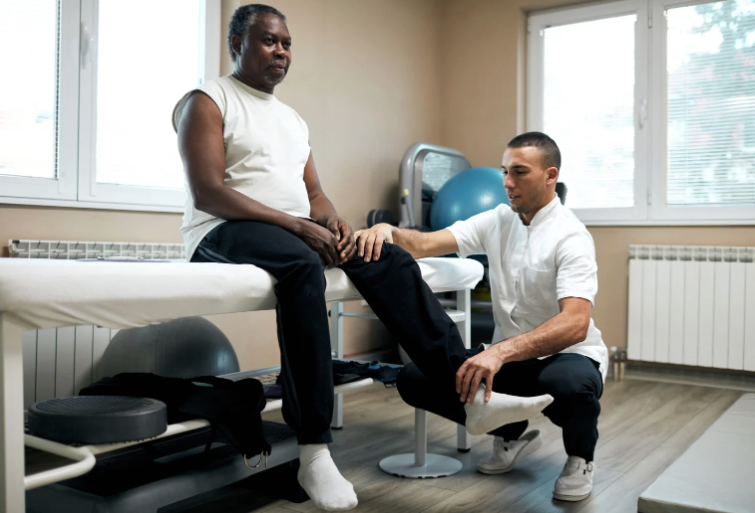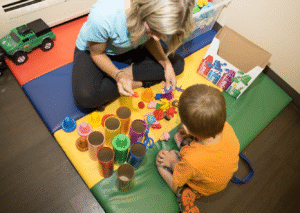At Crawl Walk Jump Run Therapy Clinic, we believe healing works best when we focus on the whole person, not just their symptoms. That’s why our team blends neurological expertise with physical therapy to create treatment plans that address both the brain and the body.
For patients with neurological conditions, this integrated approach is especially powerful. When the nervous system is impacted, it changes the way a person moves, communicates, and participates in daily life. By targeting both the source of the problem (the brain and nerves) and the outcome (movement and function), we help patients make meaningful, lasting progress.
Understanding the Neurology–PT Connection
The brain and nervous system act like the control center for every movement we make, from walking and balancing to swallowing and speaking. When something disrupts that system such as a stroke, cerebral palsy, multiple sclerosis, a traumatic brain injury, or developmental delay, it can change how the body works.
Physical therapy is often thought of as a way to strengthen muscles or improve flexibility. While that’s true, for people with neurological conditions, PT is also about retraining the brain to send the right messages to the body. When therapists understand the neurological side of movement, they can design treatment that works smarter.
How We Integrate Neurology and PT at Crawl Walk Jump Run
1. Neurologically Informed Assessments
Our evaluations go far beyond a standard muscle and joint exam. We look at:
- Motor planning (how the brain organizes movement)
- Sensory integration (how the body processes and responds to touch, movement, and visual input)
Reflex patterns (automatic responses that may still be present or interfering with movement) - Muscle tone (too tight, too loose, or inconsistent)
- Brain-body communication pathways
By identifying how the nervous system is influencing movement, we can tailor therapy to address root causes, not just symptoms.
2. Neuroplasticity-Focused Interventions
One of the most exciting aspects of neurological rehabilitation is neuroplasticity, the brain’s ability to adapt, reorganize, and create new connections. This is the foundation of recovery after injury or in the presence of a neurological condition.
We design physical therapy programs that use repetitive, task-specific movements to “teach” the brain new pathways. For example:
- Practicing the same functional task like standing up from a chair multiple times with small variations
- Using cues and feedback to help the brain recognize successful movement patterns
- Gradually increasing challenge to promote lasting change
The goal is to help the brain and body “talk” to each other more efficiently.
3. Functional Goal-Oriented Therapy
We focus on what matters most to each patient. Instead of working on isolated exercises that may not connect to daily life, we build therapy sessions around meaningful goals such as:
- Walking independently to the mailbox
- Playing on the floor with grandchildren
- Holding a utensil to feed oneself
- Navigating stairs to enter the home safely
By grounding therapy in real-world function, we make progress more motivating and directly relevant to each person’s life.
4. Multisensory and Motor Re-Education Tools
The nervous system responds best when therapy engages multiple senses. We often incorporate:
- Vibration therapy to stimulate muscle activation
- Visual tracking exercises to support balance and coordination
- Vestibular stimulation (movement that challenges balance systems)
- Universal Exercise Units for targeted strength and motor control
- Gait training systems with partial weight support for safer walking practice
This combination helps improve strength, coordination, balance, and sensory awareness all at once.
5. Collaborative, Interdisciplinary Teamwork
Neurology-informed physical therapy works best when it’s part of a bigger picture. Our PTs collaborate closely with occupational therapists and speech-language pathologists to create unified care plans.
For example:
- PT might focus on improving a child’s core strength and balance
- OT builds on that to develop fine motor control for handwriting
- Speech therapy addresses oral motor skills for clearer speech
This teamwork ensures progress is consistent and complementary across all areas of development.
Who Can Benefit?
Our integrated neurology-PT approach is ideal for both children and adults with:
- Stroke or brain injury
- Cerebral palsy
- Spina bifida
- Developmental delays
- Multiple sclerosis
- Parkinson’s disease
- Genetic or metabolic disorders affecting motor skills
For many, this type of therapy is about regaining independence and rejoining the activities they love.
The Holistic Advantage
When neurology and physical therapy work together, the results often go beyond physical improvement. Patients see benefits such as:
- Faster, more sustainable progress—because we address both the cause and the effect
- Better motor control and independence—helping with everything from walking to self-care
- Improved confidence and motivation—success in therapy builds self-esteem
- Enhanced quality of life—more participation in daily activities, hobbies, and social life
Neurology-informed physical therapy is not just a treatment—it’s a bridge between where someone is now and where they want to be.
A Real-Life Example
One of our adult patients came to us after a stroke with significant weakness on one side of her body. She had already regained some movement through inpatient rehab, but she still struggled to walk safely or use her hand effectively.
Our team created a neurology-focused PT plan that combined:
- Gait training with partial weight support
- Task-specific practice (like reaching for a cup or opening a door)
- Sensory stimulation to improve awareness in her weaker limb
- Coordination with OT to improve fine motor control
After several weeks, she was able to walk short distances without assistance and confidently prepare simple meals again, milestones that gave her back both independence and joy.
Create Lasting Change
By combining neurology and physical therapy, we move beyond symptom management and focus on creating lasting change from the inside out. If you or a loved one is navigating a neurological condition, we’re here to guide you every step of the way.
Contact us today to learn how our integrated team can help you harness the power of both neurology and physical therapy.




